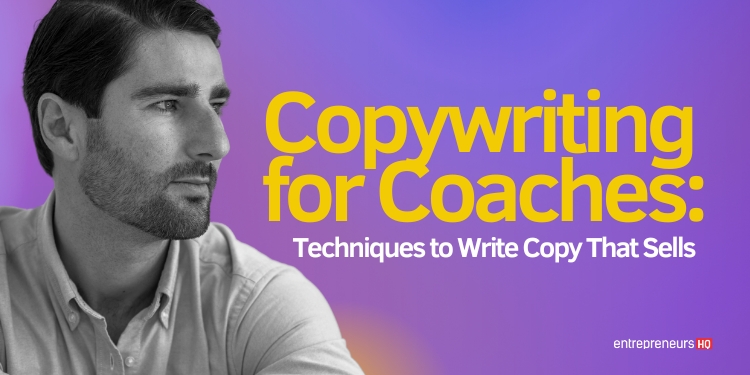
Copywriting for coaches is non-negotiable.
It’s an essential aspect of business development that can make or break your coaching practice. For this reason, you should – at the very least – familiarize yourself with copywriting principles to differentiate between good and bad copy.
But what are the frameworks, strategies, and tactics for writing more persuasive copy that sells? And, more importantly, how can you apply them to your coaching business? In this copywriting for coaches guide, we’re sharing all of that, plus some examples.
Table of Contents
Understanding the Importance of Effective Copywriting for Coaches
Copywriting is using text to sell people on doing what you want them to do – whether that’s purchasing your coaching program or signing up for your email list.
Copywriting is used in emails, sales letters, web copy, social media ads, sales funnels, and any other marketing materials designed to motivate readers to take action.
That action can be to “learn more, add to cart, click here, or buy now.” In his groundbreaking classic, “The Adweek Copywriting Handbook,” the late legendary copywriter Joe Sugarman referred to copywriting as “salesmanship in print.”
Some of the benefits of good copy include:
- Build and strengthen the image of your business
- Move prospects through your sales funnel
- Increase conversions with your target audience
- Capture or enhance your tone of voice
- Connect with your dream clients on a deeper level
- Save you time by alleviating your content marketing workload
As a result, it plays a significant role in conversions, retention rates, sales, and more. Whether it’s an email, a social media ad, a video sales letter, or website text, copywriting is essential to attracting, nurturing, and converting leads into paying customers.
There are many ways to develop this skill. You can enroll in courses, read books, attend virtual workshops, or even hire a mentor. Choose a method that works best for you, your schedule, and your budget.
Get Clear On Your Ideal Client
There’s one simple question you need to ask yourself as a coach: who are you trying to reach?
Your target market will influence and direct your copy. Unless you know your ideal client and understand their hopes, goals, pains, fears, and frustrations, writing copy that can persuade them in any meaningful way will be challenging.
You need to do a few things to understand your ideal client better.
Identify Pain Points and Desires
People buy things based on emotion and then use logic and reason to justify their purchase.
This means you must identify your target market’s pain points (negative emotions) and desires (positive emotions) to write copy that taps into those triggers. When our emotions are engaged, we become influenced to act. The reason for this is that we are all trying to do one of two things in life: move away from pain or move toward pleasure.
It’s called the Pain-Pleasure Principle.
Jane Macgregor, a Canadian health coach, is an excellent example of this.
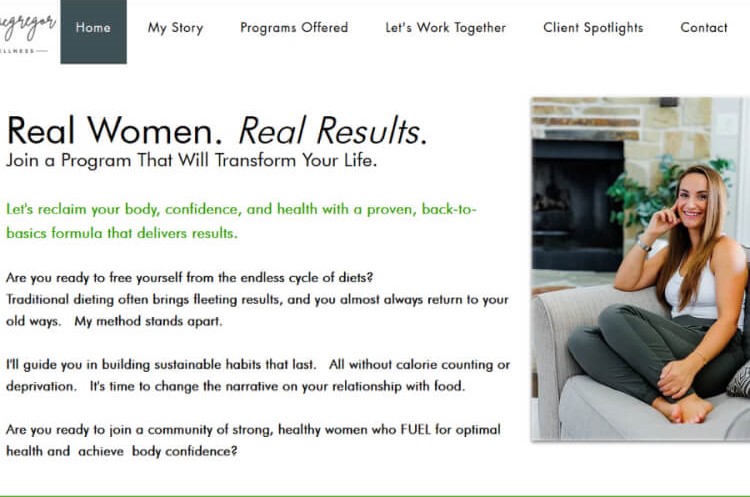
Her web copy starts with the benefit-driven statement, “Reclaim your body, confidence, and health.” She understands that her target market struggles in these areas. So, she uses simple language to tap into those struggles and then offers relief through her coaching services.
What can you learn from this example?
By understanding your market’s deepest pain points and desires, you can draft copy that speaks to and engages those emotional hot buttons. You can then write copy that positions your coaching services as the solution to their problem.
The result? You become infinitely more persuasive in your communication. And this will inevitably lead to higher conversions and more sales.
Create Client Personas
A client persona is a framework for your marketing strategy.
It provides an overview of your ideal client and serves as a reference point for your copywriting. Think of it like a blueprint that helps construct your copy. A building doesn’t get erected without a blueprint to guide the building process. Your client persona serves the same purpose for copywriting.
Your client persona profile will include specifics, such as:
- Pains and frustrations
- Goals and objectives
- Age, gender, and location
- Hobbies and interests
- Wealth and income level
- Marital status and education
To give you an example of how copywriting can target your client persona, consider Aaron and Jocelyn Freeman, relationship coaches based in Phoenix, Arizona.
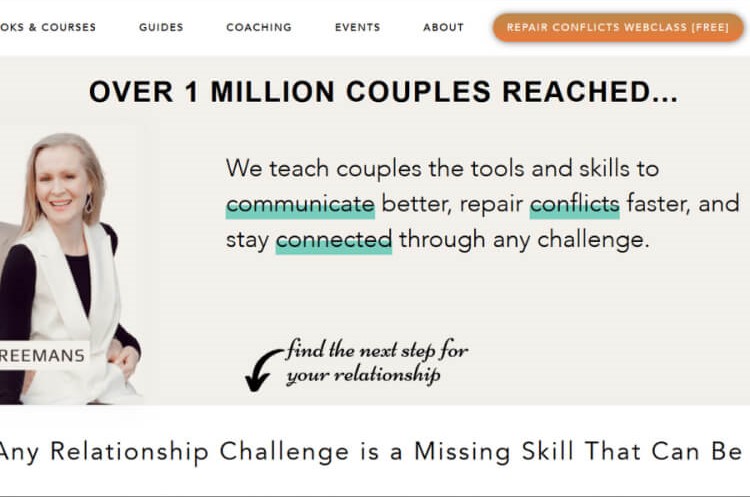
Their web copy explains who they help and what they help them with. The Freemans help couples struggling to communicate with each other to repair conflict and stay connected in their relationships.
It’s clear, it’s concise, and it gets their ideal client and unique selling proposition across.
Developing Your Unique Brand Voice
What comes to mind when you think of the retail giant Amazon?
Probably words like reliable, convenient, and customer-centric. The company has built a reputation on the “push-button” ease associated with ordering from its site. But how did all these ideas flood your mind just by thinking about Amazon? It’s due to the power of branding.
However, branding goes far beyond mere mental images.
It also encompasses the words, phrases, and language you use to communicate with your audience. This is as true for retail giants as it is for coaches. Your brand voice is your differentiator.
It builds trust, conveys personality, and separates you from the competition.
Moreover, your voice is a part of your brand identity. Copywriting can help you convey your message and align it with your brand to create consistency (and, as a result, trust) with your market.
Aligning messaging with brand identity
Your brand and your messaging should come together harmoniously.
The blend of these two elements is what makes you stand out, as it conveys your individuality. A perfect example of this would be Michal Eisikowitz. She’s a conversion-driven web copywriter and copywriting coach from New York.
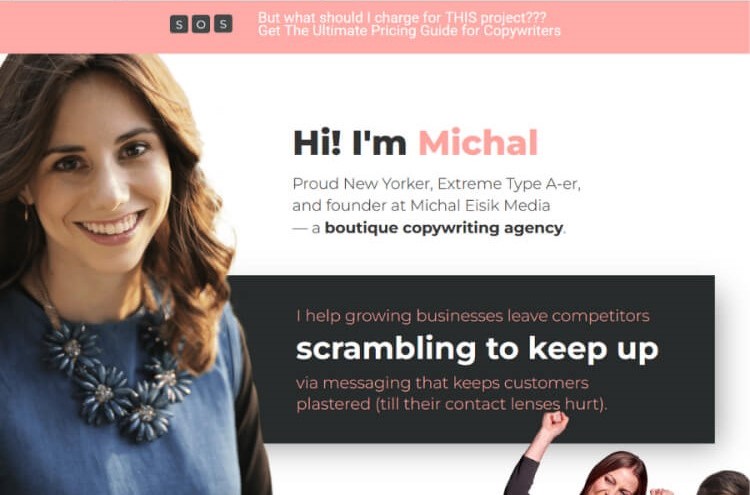
Her uniqueness shines through as she infuses her personality into her copy.
Eisikowitz does this using cheeky and competitive language. And the most interesting part? She pulls this off without compromising her message of being a top-tier, professional copywriter who delivers tangible results for her clients.
So, what can you learn, as a coach, from Michal Eisikowitz?
Be yourself when determining your messaging and brand voice. Standing out in the coaching space is a matter of uncovering your unique brand voice and using it to connect with others to build that trust and authority.
Creating your brand voice guidelines
Like anything else, success in creating your brand voice is a process.
It’s comprised of a series of steps that, if followed, can help you establish your own unique voice as a coach in the marketplace and among your clients. Consider the following guidelines for creating your brand voice:
- Get clear on your vision. Your vision represents the impact you want to have, and it determines your tone and language. For example, if your vision as a coach is to create a world of successful entrepreneurs by helping them grow their income and influence, then your voice would reflect this vision in very potent, powerful, and motivational language. Conversely, if your vision is to see trauma victims heal and lead normal lives again through your coaching, your tone and word choice would be softer and gentler.
- Imagine your ideal client. When you understand the persona you want to target, it becomes easier to determine the words, phrases, and tones that would be most appropriate to engage them. A good tactic to learn more about your audience is to find successful coaches within your niche, find books and products on Amazon, and scour customer reviews. Pay attention to the pains and desires in the reviews. These people are essentially telling you what they want and need.
Proven Copywriting Frameworks You Can Use To Write More Persuasive Copy
You don’t have to reinvent the wheel when writing your copy.
There are many tried-and-true methods that generate results. For this reason, all you need to do is take the time to learn a few copywriting principles and fundamentals.
4Ps: Picture, promise, proof, push
The 4P framework is a copywriting system used to create intrigue and compel readers to take action. It focuses on benefit-driven results for the reader.
1. Picture
People are visual creatures.
For this reason, you need to paint the picture of how your coaching will improve their lives. You can do this by using descriptive and emotional language. This is not the stage for facts, figures, and statistics.
Yes, those factors have their place in persuasion.
However, at this stage, you want prospects to imagine what life could be like if they decided to work with you. This technique, also known as future pacing, should be used as early as possible to get prospects excited about your offer and hooked into reading the rest of your copy.
2. Promise
Every reader is asking one question when they stumble on your copy: What’s in it for me?
This is why you have to make them a benefit-driven promise – something that makes it worth their while to stick around and continue reading. This is your big claim. It’s how you gain and keep attention.
The best places to put your big claim are in the headline and the lead of your copy.
This promise gets prospects interested in reading your content. However, you can’t just make bold claims to hook people. You have to support your claims and promises with actual proof.
3. Proof
You now need to support your claims with proof.
This is where facts, figures, and statistics come into play. Your prospect is interested at this point (or, at the very least, curious). However, they more than likely still have a little voice in the back of their minds, feeding them reasons to back out.
“Maybe this coach is a scam.”
“Coaching probably won’t work for me.”
“How can I justify this purchase?”
These are what we call objections. While they may not be outright disagreements against what you’re saying or offering in your copy, you have to address them as if they are. Bypassing this stage requires you to present evidence to back your claims.
Examples of supportive evidence can include the following:
- Case studies
- Positive reviews
- Testimonials
- Facts and figures
- Research and statistics
4. Push
Push is the last step in the 4Ps and encompasses your offer.
You want to get creative when it comes to pushing prospects to that final CTA. It must be a persuasive reason for them to take action now. Additionally, you can also use this step to summarize your offer, further cementing the value you’re providing.
Lastly, if you have any guarantees, discounts, or free bonuses, this would be an appropriate place to post them.
AIDA: Attention, interest, desire, action
One of the most popular and well-known copywriting frameworks is AIDA.
Its four stages are Attention, Interest, Desire, and Action. This model provides structure to your content in the order of attracting attention to your coaching practice, generating interest in your services, arousing a genuine desire for them, and spurring readers to action to hire you.
Here are the steps in a little more detail:
- Attention: Perhaps the best way to attract attention in your copy is to use shocking statistics or studies. Of course, ensure you’re getting these studies from trusted and credible sources and link them out to support your attention-getting claim. You can also use stories or brash statements/opinions to garner attention.
- Interest: Once you have attention, you now need to hold it. This is where benefit-driven copy is useful. You share stories, examples, or even hypothetical scenarios of others who used your solution to alleviate their pain points and frustrations.
- Desire: You have to use your copy to create a gap in your prospects’ minds between where they are and where they want to be. Then, you position your solution (your coaching services) as the bridge that connects the two touchpoints. You also have to establish credibility via social proof using testimonials or “before and after” type content. This can help to arouse the desire that will compel your readers to act.
- Action: Now, the moment of truth. You need to add a compelling call to action (CTA). Don’t let all your hard work go to waste by throwing in a weak CTA that doesn’t inspire readers to act now. Your CTA should be clear, easy, and prominent. Add a large button that tells prospects the exact action they must take to claim your offer. Make it effortless and eliminate as much friction as possible to improve your conversions.
Before-After-Bridge: Before-state, after-state, bridge to achieve the after state
The Before-After-Bridge (BAB) formula is a copywriting storytelling technique.
It uses a descriptive narrative to paint a picture of your client’s pain points in their current situation. However, it then transitions into showing clients their dream circumstances, using your coaching services as the bridge that connects the two timelines.
Here’s how you can use this technique in your copy:
- Dig into their pain. You need to tap into the pain of your target market using story-driven copy. For example, if your coaching clients are struggling to stick to positive habits that are aligned with their goals, talk about the frustration they’re experiencing every time they fall back into old routines. Mention the shame and guilt that washes over them and how it will only get worse if they don’t change their patterns. This is not to be negative or berate them. It’s a form of priming that gently leads them to a solution – your coaching services.
- Illustrate the possibilities. Next, you need to illustrate what possibilities are available. Paint a picture of the “after state” that your clients will experience if they find the solution to their problems. A tip to doing this step is to use the word “imagine” to begin painting that picture. The sentences that flow from the word “imagine” will describe all the benefits your clients will enjoy if they only had the secret to solving their problems.
- Bridge the gap. So, you’ve used effective storytelling to explore the pain. Then, you’ve illustrated the benefits of overcoming the pain if only a solution were available. This third step is where you introduce clients to that solution, which, in this case, would be your coaching services.
FAB: Features, advantages, benefits
This framework answers the question: what’s it in for me?
Remember, your copy must be reader-focused. People won’t pay attention to it unless there is some benefit they will gain from reading. The FAB formula is a proven tactic that will help you write compelling sales copy. However, the caveat is that you must first dial in your niche, client persona, and UVP (Unique Value Proposition).
Let’s explore each of the FAB elements in more detail.
- Features: Features are the properties of your coaching services. For example, helping your clients explore their motives and ambitions through detailed questioning is a feature of your services. It’s a tangible attribute connected to your coaching.
- Advantages: Advantages are the aspects of your coaching that directly affect your client. Sticking with our previous example, an advantage of quality questions in your coaching would be that clients gain a deeper understanding of themselves and their values.
- Benefits: This is what your clients really care about. Keeping with our example, a benefit of your coaching services would be that clients become aligned with their true values and principles. As a result, they can make wise decisions in business, relationships, and life that contribute to their happiness and well-being.
Here’s a simple framework to use the FAB formula in your copy:
- Choose a unique feature. For example, let’s say a feature for your coaching services is that you’re certified by a governing body within your industry.
- Explain the advantage. The advantage in this example would be expert coaching services provided by a certified professional.
- Give the benefits. Piggybacking on our example, your clients would gain transformational change from a proven framework taught and backed by a governing body within the coaching industry.
PAPA: Problem, agitate, persuade, ask
The PAPA formula follows a Problem, Agitate, Persuade, Ask framework.
As such, it shares a structure similar to that of the BAB system. It focuses on emphasizing your client’s problem, making them acutely aware of their struggles to capture attention long enough to present a solution.
Here is how the formula works and how to use it in your copy:
- Problem: Acknowledge the pain points and struggles associated with the problem your ideal client is experiencing.
- Agitate: Agitate those pain points and struggles to make your target market realize the size of their problem and that they need a solution.
- Persuade: Tell your audience that your coaching services are the solution that can help alleviate their pain and solve the problem.
- Ask: Create a compelling call to action that encourages your prospect to take the next step (e.g., book a Discover Call, sign up for your newsletter, buy a coaching package).
PAS: Problem, agitate, solution
The PAS formula structures your copy to make it precise and persuasive. It does this by honing in on your client’s problem, agitating it, and then offering a solution.
Imagine you coach startup entrepreneurs on how to grow and scale their budding businesses. Here’s an example of what the PAS formula would look like with that particular segment of the market:
- Problem: Tired of seeing leads fall through the cracks in your sales funnel?
- Agitate: It’s disheartening to lose qualified leads unnecessarily because your sales funnel lacks a few key elements that could skyrocket conversions.
- Solution: Our sales funnel coaching program offers a step-by-step framework so you can effortlessly move prospects through the customer journey, track behavior and engagement, and optimize your sales funnel to increase conversions.
The PAS formula works because it acknowledges your market’s problem, intensifies it to trigger an emotional reaction, and provides a user-friendly solution.
StoryBrand: Character, problem, guide, plan, call to action
StoryBrand is one of the best copywriting strategies for communicating your value proposition.
However, there’s a twist. The narrative is delivered with your client as the hero – the main character. They are the ones going through the storyline, facing difficulties, and searching for a solution. And that’s where your coaching arrives, serving as the saving grace that empowers the client to triumph and reach their goals.
Here’s how you can use the StoryBrand formula in your copy:
- Character: Determine your ideal client (what their desires, hopes, and dreams are). Who are you trying to reach – what segment of the market do you serve?
- Problem: Identify their obstacles and consider how your coaching can help them overcome those difficulties. Your coaching must meet a specific need in the market.
- Guide: The guide portion of the StoryBrand framework is where your coaching services come into play. So, you’ll want to position yourself as the guide who possesses the knowledge and experience in the form of an effective solution.
- Plan: Now, you must provide your client with a simple plan to help them overcome their obstacles. You have to outline a process they can follow to get from A to B.
- Call to Action: Invite your client to take action toward resolving their problem. This action can come in the form of signing up for your newsletter or booking a discovery call.
- Avoid failure: Here, you’ll detail the consequences of not taking action. You’ll really want to emphasize the pain points your client will experience for failing to act.
- Success: At this stage, you’ll describe what success looks and feels like. Go into detail to paint a picture of all the pleasurable things that can happen if clients follow through.
Direct response copy
Direct response copy is a copywriting variation designed to prompt the reader to take immediate action. Some of its elements include an engaging headline, a sense of urgency, and a compelling call to action that encourages the reader to perform a specific action immediately.
A few of the most well-known direct response copywriters (past and present) include:
- Gary Halbert
- Bob Bly
- David Ogilvy
- Joe Sugarman
- Mark Ford
- Eugene Schwartz
- Claude Hopkins
- Dan Kennedy
- John Caples
Tony Robbins, the world’s most successful and well-known life coach, uses his direct response copy exceptionally well on his Date With Destiny page.
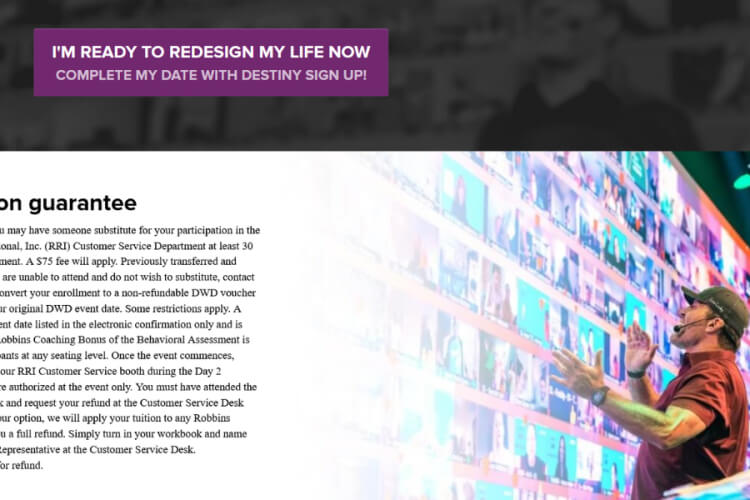
The page starts with the power benefit-driven headline “Rewire your mind, redesign your life.”
It then flows with the same intensity down the page, keeping the reader’s attention. Moreover, everything about the copy is reader-centric. Not once does the text deviate from keeping the reader at the forefront. And then it ends with a strong CTA: “I’m ready to redesign my life now.”
Best Practices For Writing Powerful Headlines and Hooks
Your headlines are the most important piece of your copy.
You could have the most persuasive copy in the world, but if your headline doesn’t draw people in, then all of it is for nothing. Luckily, there is a very simple framework that can help guide the process of drafting headlines.
It’s known as the four U’s.
The four U’s of headline copy
Originally created by legendary copywriter and businessman Mark Ford, the four U’s are a powerful framework for drafting effective headlines. The best part? This framework applies to almost any headline copy, from an email subject line to a sales letter hook.
Let’s take a deep dive into the four U’s:
- Urgent: Adding urgency gives the reader a reason to act now. If people believe the opportunity will be around forever, there’s no fear of loss. As a result, the offer loses value as people believe they can “get around to it later.” And when “later” comes around, you can bet that they’ve long since forgotten all about the opportunity.
- Unique: People love new and novel things. Shiny Object Syndrome is real. We are captivated when something we’ve never seen before is brought to our attention. For this reason, your headline should be something novel. Now, if there’s nothing truly unique about your topic, then think about putting a new spin on it to give a unique appeal.
- Useful: Your headline must deliver something useful, some type of benefit that will make the reader’s life better. Otherwise, what incentive do they have to read your copy?
- Ultra-specific: Don’t tell the reader your coaching program will improve sales by 50%. Tell them it will improve sales by 54.3%. Don’t tell them that 90% of your previous coaching clients have exploded their businesses. Tell them that 91.8% have. Ultra-specificity creates believability in the eyes of the reader. It makes your claims feel more tangible and real. So be as specific as you can without lying about the numbers.
Best Practices for Writing Persuasive Sales Copy
Effective copywriting uses various tactics and techniques to stir your reader’s emotions, compelling them to take the action you want them to take. As such, copywriting is one of the most powerful tools for growing your practice and landing more high-paying coaching clients.
Here are some of the techniques you must infuse into your copy:
Storytelling
Humans are compelled by stories.
We can’t help but become engrossed in an engaging narrative as stories captivate our attention and emotions. For this reason, storytelling is a powerful persuasion tactic that can help you create parallels in your readers’ minds that can inspire them to take action.
Here is an example of storytelling by copywriting coach Ian Stanley via email. His story details how a married couple purchased his copywriting and marketing mastermind group.
And subsequently made over $400,000 in a day.
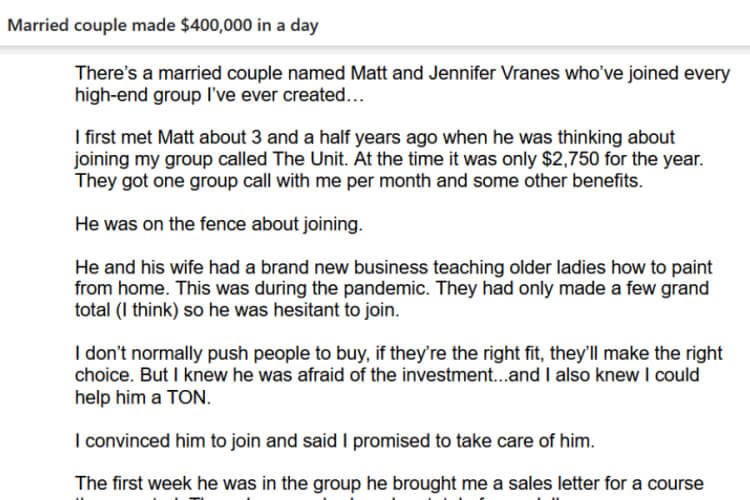
He details their work ethic (acknowledging that his tactics don’t work unless you do), their belief in the process, and their ability to take and apply constructive feedback to get results! At the end of the email, he then throws in a strong CTA to encourage readers to join the group themselves.
Social proof
Social proof is one of the most powerful forms of persuasion.
Most people naturally have a herd-like mentality. As such, they feel safer knowing others have had positive experiences with a seller of services. There are many things that can act as social proof. Some of these include:
- Testimonials
- Case studies
- Endorsements
- Certifications
- Media mentions
- Statistics
- Approval from experts
Here is an example from Chris Williamson’s (a popular YouTuber and Podcaster) Instagram post with Sam Harris.
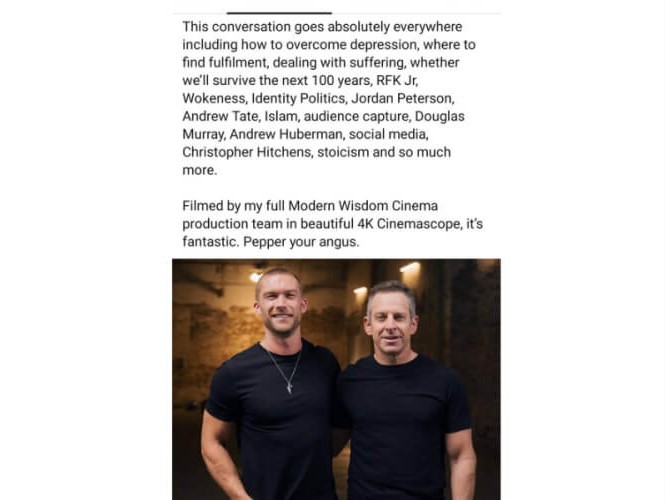
The caption teases the conversation topics covered in his podcast with American neuroscientist and philosopher Sam Harris. Harris is a prominent public figure due to his critical views on faith and religion. Williamson promotes his podcast using Sam Harris as social proof to encourage people to tune in to its release.
Reframes
Reframes are a powerful yet under-discussed copywriting tactic.
To use a reframe in your copy, repeat the same information in a different way. For example, if you’re a financial coach who helps young people save for retirement, you could discuss the gains of certain investment options.
“This mutual fund averages 12% annual returns. That means your $50,000 nest egg will grow by $6,000 in one year, and then your $56,000 nest egg will grow by $6720 the next year, and so on! And you didn’t do a single thing except put your cash in the investment.”
That is a reframe.
You’re just putting a new spin on old information. This tactic makes your offer feel more realistic and persuasive. It creates a sense of tangibility for the reader that stirs their emotions, making them more likely to take action on your claim.
And it works on web copy, sales emails, social media posts, or any other medium.
Here is an example of Elliot Hulse (a men’s strength and conditioning coach) using the reframe technique for a sales letter on his website.
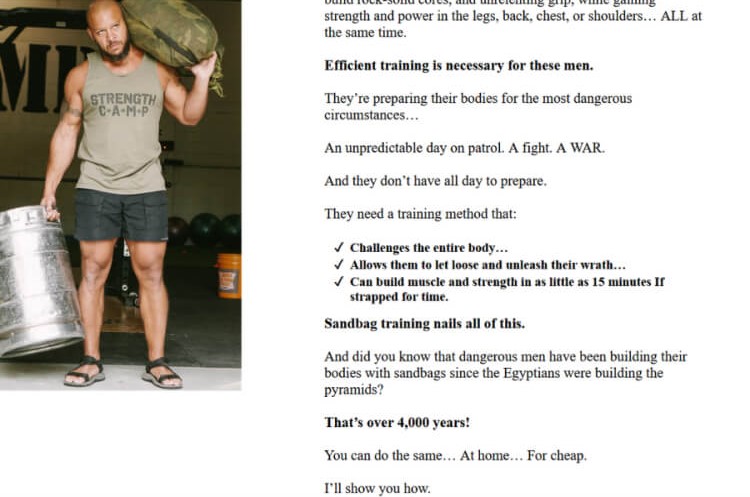
At the bottom of the page, he mentions how men have been using sandbags since the time of the Egyptians. He then exclaims, “That’s over 4,000 years!” using the reframe to give his copy life and dimension.
Vulnerability
Vulnerability is a superpower in sales copy.
Why? Because all of us have shortcomings, flaws, and faults. When you are vulnerable in expressing yourself, you create rapport with the reader. You can become more relatable and, as a result, more “human.” This then establishes a connection and a deeper trust level because the reader feels understood since you’ve “been in their shoes.”
Bedros Keuilian is a serial entrepreneur and business coach from California. In his sales copy, he demonstrates vulnerability by admitting he never had any real models growing up.
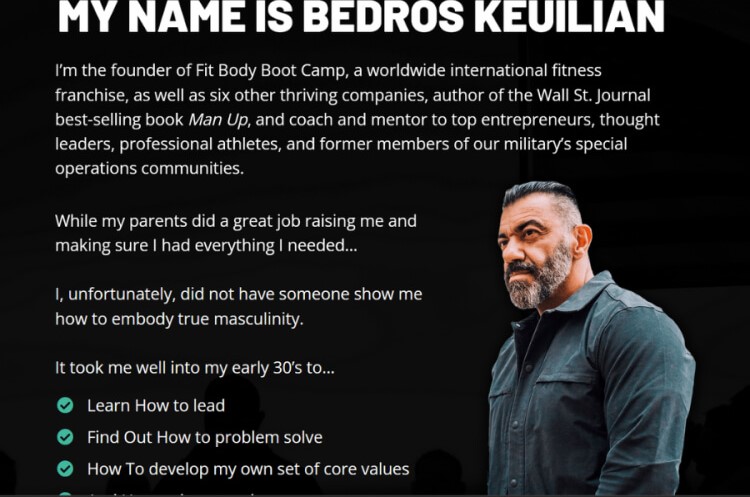
While it may feel uncomfortable to share sensitive aspects of yourself, it can be a powerful way to establish a connection with your readers.
Moreover, it’s an important element in creating the know, like, and trust factor for prospects. To use vulnerability effectively in your copy, share personal experiences that have impacted and influenced your life. Delve deep into the emotions you felt and the lessons you learned.
This is how you create meaningful connections with readers, almost to the point where they feel like they “know you.”
When to Hire a Copywriter for Your Coaching Business
While it’s important to learn the basics of copywriting as a coach, there will come a time when you’ll want to outsource this responsibility as your business grows. So, the question becomes: When does it make sense to hire a copywriter for your coaching business?
And the answer is… it depends.
If you’re a brand-new coach with no marketing budget, learn the skill of copywriting yourself and do the best you can on your own. It’s never worth going into debt to hire a copywriter, especially if you’re just starting out. Now, if you’re a little more established, with, say, five to ten (or more) coaching clients and a marketing budget, that’s when it makes more sense to hire a copywriter to help refine your messaging.
But until then, do it on your own. There are plenty of resources that can help you learn this skill. Here is a small list of books to get you started:
- The Adweek Copywriting Handbook (Joe Sugarman)
- The Copywriter’s Handbook (Bob Bly)
- The Ultimate Sales Letter (Dan Kenndy)
- Breakthrough Advertising (Eugene Schwartz)
- Scientific Advertising (Claude Hopkins)
- The Boron Letters (Gary Halbert)
How to Hire and Vet a Copywriter
Now, you may be wondering how you can find a copywriter for coaches. There are a few ways: You can post ads on job boards, announce that you’re looking for copywriters on LinkedIn or other social media platforms, network by attending events such as conferences or virtual summits, or even tap into your current network by asking associates, colleagues, and acquaintances.
Here are a few useful tips for vetting copywriters for your coaching business:
- Experience: Ensure you inquire about their previous experience. Ask about who they’ve worked with and the results they’ve generated. You should also ask for samples of past work, as this will allow you to gauge the quality of their writing.
- Niche: Have they worked with coaches before? Or is their experience entirely in another field? This is an important consideration. A copywriter experienced in writing in the coaching niche will draft higher-quality copy faster than someone who has written in an unrelated field.
Another aspect of the hiring process to consider is red flags. If you aren’t paying attention, it becomes very easy to overlook glaring warning signs that could spell disaster for your business.
Here are a few red flags that you should steer clear of:
- Bold, suspicious promises without any proof to back up their claims
- No portfolio, website, or social media presence
- A condescending know-it-all attitude
- Underpriced rates (if it’s too good to be true, it usually is)
- Poor communication and time management skills
How to Optimize Your Copy Over Time
Writing copy is not a set-it-and-forget-it activity. It should be tweaked and optimized over time. As such, it’s important to monitor your copy’s performance and consider ways to enhance it. Here are a few simple tips to start that process.
Conduct A/B tests
A/B testing (also called split testing) is the process of showing two or more versions of copy to different segments of your email list or site visitors. Your aim is to see which version produces the best improvements in business metrics. Here is how you can conduct your own A/B tests:
- Determine your goal. Define the desired outcome of your split test. It could be to increase click-through rates on your emails or to boost sales on a product page. The measurement of success is completely up to you.
- Pick a testing variable. What will you test? The headline, image arrangement, hooks, messaging, or CTA? Choose one variable at a time and see if the change you make yields any favorable results.
- Launch the test. Run your test. Use each version at the same time for a predetermined period or until you’ve gained the information you need.
- Review the results. Analyze the information after the test is complete. Look at the results to see if the changes weren’t due to chance.
- Repeat. A/B testing is a continual process. The insights you receive from one test help you develop new ideas for the next. Each test helps you fine-tune your copywriting so you’ll begin making better data-driven decisions.
Conclusion
Copywriting is a skill you should invest in. Moreover, as a coach, you understand the necessity of investing in your business. This is how you expand your practice. And we at Entrepreneurs HQ are here to help with that process.
Be sure to sign up for our 6-Step proven checklist to generate more leads and ideal clients from a virtual summit.